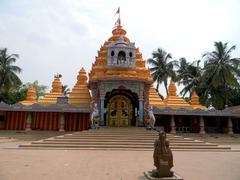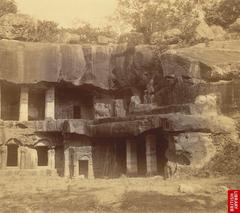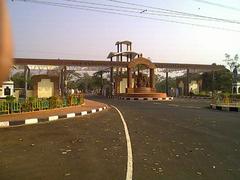
Labesvara Siva Temple Bhubaneswar: Visiting Hours, Tickets, and Travel Guide
Date: 04/07/2025
Introduction to Labesvara Siva Temple
Situated in the historic Old Town of Bhubaneswar, Odisha, the Labesvara Siva Temple is a distinguished icon of spiritual devotion and Kalinga architectural splendor. Known as the “Temple City of India,” Bhubaneswar is celebrated for its exceptional cluster of ancient shrines, with Labesvara Siva Temple—a 14th-century sanctuary dedicated to Lord Shiva—standing as a vital testament to the city’s religious and artistic heritage (Indianetzone). The temple is renowned for its mature pidha order vimana, exquisite sandstone carvings, and vibrant religious traditions that have been preserved over centuries.
Labesvara Siva Temple’s significance lies not only in its architectural features but also in its role as a living center of community worship, especially during festivals like Maha Shivaratri. Integrated into the sacred geography of Ekamra Kshetra and the Astasambhu circuit, it attracts pilgrims, travelers, and heritage enthusiasts seeking to experience the spiritual and cultural vibrancy of Odisha (Native Planet, TripXL, travelsnwrite.com, Trek Zone, The Floating Pebbles).
Table of Contents
- Historical Background and Origins
- Architectural Features and Kalinga Style
- Iconography and Artistic Detailing
- Religious and Cultural Significance
- Practical Visitor Information
- Festivals and Community Life
- Facilities and Amenities
- Conservation and Heritage Management
- Nearby Attractions and Suggested Itinerary
- Accommodation Options
- Safety and Responsible Tourism
- Frequently Asked Questions (FAQ)
- Visuals and Media Recommendations
- Conclusion and Travel Tips
- Sources and Further Reading
Historical Background and Origins
Labesvara Siva Temple, also referred to as Hanumantesvara, was constructed in the 14th century CE as part of the flourishing Shaiva tradition in medieval Odisha (Indianetzone). Its location in Bhubaneswar’s Old Town places it among several historic temples, including Ramesvara, Laxmanesvara, and the revered Lingaraj Temple. The temple reflects the evolution of Odishan temple architecture and serves as a critical piece in the city’s extensive religious tapestry.
Architectural Features and Kalinga Style
The temple exemplifies the mature phase of the Kalinga architectural tradition, using sandstone and dry masonry. Its vimana (sanctum tower) stands at 5.04 meters high, with a pancharatha plan—five projections on each side—demonstrating the geometric and proportional sophistication of the period (Indianetzone). The iconic curvilinear shikhara and detailed carvings are hallmarks of the Kalinga Nagara style (travelsnwrite.com).
The temple’s layout features a sanctum (garbhagriha), jagamohana (assembly hall), and a small mandapa. Its external walls display intricate carvings, mythological motifs, and decorative elements such as the Gajalakshmi on the lintel. The circular yonipitha in the sanctum symbolizes the union of Shiva and Shakti.
Iconography and Artistic Detailing
Labesvara Siva Temple’s sculptural program includes niches housing images of Parvati, Kartikeya, and a now-ruined Ganesha (Indianetzone). The door jambs, pilasters, and external friezes exhibit floral motifs, dancers, musicians, and scenes from Hindu epics—exemplifying the region’s artistic excellence (Search O Things).
Religious and Cultural Significance
Central to the Shaiva tradition, the temple is an active site of daily worship, ritual observances, and major celebrations like Maha Shivaratri and Kartik Purnima (TripXL). Rituals include abhisheka (bathing of the Shiva lingam), offerings of bilva leaves and flowers, and recitation of Vedic hymns. Tantric practices and festivals reinforce the temple’s role as a custodian of Odisha’s spiritual heritage.
The temple is also a hub for community gatherings, with Odissi dance and music performances during festivals, fostering cultural continuity and social cohesion (Search O Things).
Practical Visitor Information
Visiting Hours & Entry Fee
- Timings: Open daily from 6:00 AM to 8:00 PM (The Floating Pebbles; confirm locally during festivals).
- Entry Fee: Free for all visitors; donations are appreciated.
How to Reach
- Location: Old Town, Bhubaneswar—part of Ekamra Kshetra (stampedmoments.com).
- Nearest Railway Station: Bhubaneswar Railway Station (approx. 5 km).
- Nearest Airport: Biju Patnaik International Airport (approx. 4–6 km).
- Transport: Easily accessible via auto-rickshaw, taxi, and public buses.
Accessibility
- The temple has paved pathways but some uneven surfaces; limited facilities for visitors with mobility challenges.
Dress Code and Etiquette
- Modest attire recommended; sarees for women and dhotis or long pants for men appreciated.
- Remove shoes before entering; avoid carrying leather items.
- Non-Hindus may not be allowed in the innermost sanctum but can visit outer areas.
Photography Guidelines
- Photography permitted in outer precincts with permission; prohibited inside the sanctum. Silence mobile phones and minimize noise.
Festivals and Community Life
Festivals such as Maha Shivaratri and Shravan Mondays draw large gatherings, with elaborate rituals, night vigils, and cultural performances (The Floating Pebbles). The temple’s syncretic worship practices reflect a blending of mainstream Hinduism with local traditions, fostering inclusivity and pluralism (Native Planet).
Facilities and Amenities
- Basic Amenities: Drinking water and restrooms available near main temples; shops selling offerings and prasad at the entrance.
- Food: Nearby eateries serve traditional Odia and vegetarian cuisine.
- Guided Tours: Local guides and heritage walks are available for deeper insights into the temple’s history and architecture.
Conservation and Heritage Management
Despite facing challenges like sandstone erosion and minor structural cracks, Labesvara Siva Temple is maintained by local trusts and heritage authorities. Restoration efforts prioritize use of original materials and preservation of the temple’s historical character (Wikipedia, hinduphilosophyholypilgrimage.blogspot.com).
Nearby Attractions and Suggested Itinerary
- Lingaraj Temple: Bhubaneswar’s largest and most revered Shiva temple.
- Mukteswar Temple: Renowned for its ornate stone arch and carvings.
- Bindusagar Lake: Sacred water body adjacent to Lingaraj Temple.
- Rajarani Temple: Noted for its red sandstone architecture.
- Udayagiri and Khandagiri Caves: Ancient Jain sites (Trek Zone).
Suggested Itinerary:
Morning visit to Labesvara Siva Temple, followed by Lingaraj Temple and Bindusagar Lake; lunch at a local eatery; afternoon at Udayagiri and Khandagiri Caves.
Accommodation Options
Bhubaneswar offers a range of accommodations from budget lodges in Old Town to luxury hotels in the city center. Notable stays include OYO 14988 Regal Stays, Atithi, and Mango Hotels Prangan (The Floating Pebbles; Scribd Guide).
Safety and Responsible Tourism
Bhubaneswar is generally safe, but visitors should remain vigilant with personal belongings. Support sustainable tourism by respecting temple rules, avoiding litter, and purchasing craft items from authorized vendors.
Frequently Asked Questions (FAQ)
Q: What are the visiting hours of Labesvara Siva Temple?
A: The temple is open daily from 6:00 AM to 8:00 PM.
Q: Is there an entry fee or ticket required?
A: Entry is free; donations are welcome.
Q: Are guided tours available?
A: Yes, local guides offer tours; group heritage walks are also available.
Q: Can non-Hindus enter the inner sanctum?
A: Generally, non-Hindus are not allowed inside the sanctum but can explore the outer precinct.
Q: Is photography permitted?
A: Permitted in outer areas with permission; not allowed inside the sanctum.
Visuals and Media Recommendations
Include high-quality images of:
- Labesvara Siva Temple’s vimana and shikhara (alt: “Labesvara Siva Temple Bhubaneswar exterior view”)
- Detailed doorjamb carvings (alt: “Intricate carvings on Labesvara Siva Temple doorjambs”)
- The peaceful temple courtyard and festival celebrations (alt: “Maha Shivaratri festival at Labesvara Siva Temple”)
Interactive maps and virtual tours are recommended for enhanced planning.
Conclusion and Travel Tips
Labesvara Siva Temple is both a historical gem and a vibrant center of worship in Bhubaneswar. Its Kalinga architecture, active ritual life, and integration within the city’s network of sacred sites make it a must-visit for devotees, heritage seekers, and travelers.
Plan your visit during early mornings or winter months for a tranquil experience, and immerse yourself in the spiritual and cultural ethos of Odisha.
Download the Audiala app for personalized travel guides and event updates, and follow us on social media for insights into Odisha’s living heritage.
Sources and Further Reading
-
This article draws on authoritative resources for accuracy and detail. Explore more at the following:
- Labesvara Siva Temple Bhubaneswar: History, Architecture, and Visitor Guide, Indianetzone
- Discover Labesvara Siva Temple: Visiting Hours, Tickets & Historical Significance in Bhubaneswar, Native Planet
- Labesvara Siva Temple Bhubaneswar: Visiting Hours, Tickets & Architectural Highlights, travelsnwrite.com
- Labesvara Siva Temple Bhubaneswar: Visiting Hours, Tickets & Travel Guide, The Floating Pebbles
- Labesvara Siva Temple, Wikipedia
- Labesvara Siva Temple Bhubaneswar, Trek Zone
- History of Odisha, History of Evolution of Temple Architecture in Odisha
- Fabhotels Blog on Temples in Bhubaneswar
- TripXL Blog on Shiva Temples in Odisha
- stampedmoments.com
- hinduphilosophyholypilgrimage.blogspot.com
- Scribd Guide
- Search O Things









